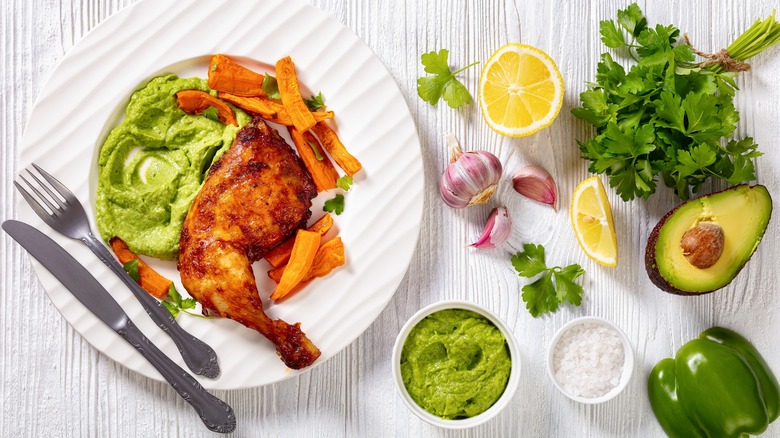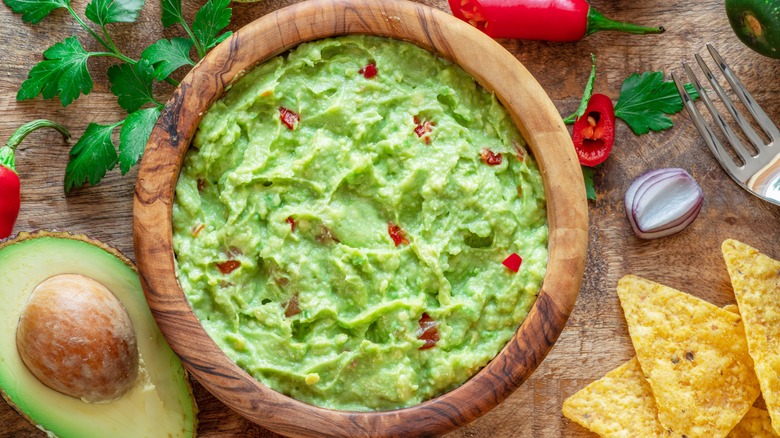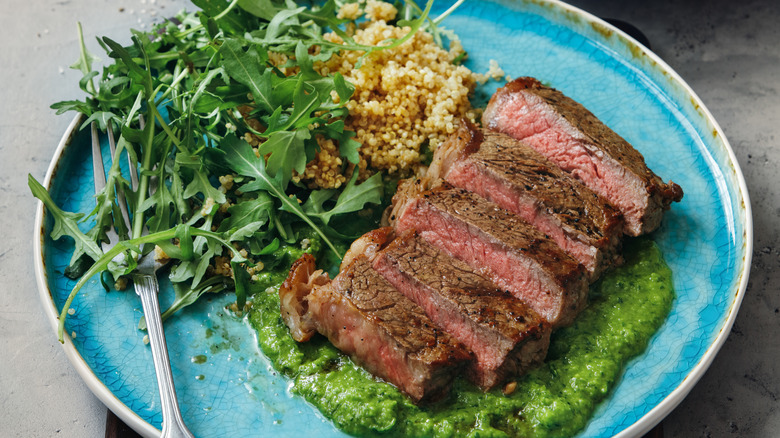Guasacaca Is A Venezuelan Sauce That's Not Afraid Of Avocados
Venezuelan guacamole, green sauce, or avocado salsa are just a few of the terms used to describe guasacaca, a delicious herbaceous avocado-based condiment. Variations of herby, sometimes spicy green sauces appear throughout South America, but guasacaca is pretty uniquely Venezuelan. When a lot of us see a dish of mashed avocados, we automatically assume it's guacamole, but there's a wide world beyond it.
Guasacaca uses avocado and oil to give it extra creaminess, and a lightly viscous consistency. Because of this, it can be used both as a topping, dip, or dressing. Just like arepas, guasacaca is a staple of Venezuelan cuisine. In addition to its culinary use in South America, it's also a culturally significant condiment. In a piece by Remezcla, Venezuelan chef Luis Herrera said, "It unites social classes and different types of people. I remember eating it as a kid," adding later in the piece, "Guasacaca is a very good example of the legacy and the way we can preserve and keep memories."
Beyond avocados
In addition to avocados, guasacaca also includes a few other ingredients, though, of course, this can vary from region to region and family recipe to recipe. A few of the common vegetables you'll see included are green bell peppers, garlic, onions, and lots and lots of cilantro. You can also use jalapeños, serrano, and other chile peppers, but they aren't typically included. Some folks mix the sauce with water to get it to blend properly, but olive oil is more common as it adds to the creamy emulsion factor without diluting the bright flavors of the herbs, garlic, and avocado. Olive oil is most often called for, though avocado oil would also likely work beautifully.
But perhaps the ingredient that makes guasacaca such a distinct flavor, is its use of vinegar. Other South American herby sauces might call for lime juice and other citruses, but guasacaca almost always includes a splash of vinegar, with some recipes calling for red wine, apple cider, or regular white vinegar. This gives the sauce a punchy, sharp flavor that makes it ideal as a side dish for ultra-savory asado and a bright addition to starchy vegetables like plantains, potatoes, and cassava (yuca), another Venezuelan diet staple.
Variations across Venezuela
There are many versions of guasacaca, and it would be impossible to say there's any one true, authentic recipe. But most often, it includes avocado, bell peppers, oil, and cilantro, at a minimum. However, some Venezuelan recipes actually exclude the avocados altogether as well. This probably seems contradictory, but the origins of guasacaca are so far back in the past, even what is now thought of as standard was at one time an innovation. The avocado-less version is still common in food carts in town squares, potentially because the avocado might brown if prepared too far in advance, or because it's easier to distribute less chunky sauces for the masses.
Avocados are generally mild in flavor, but renowned for their creamy texture and healthy fats. Without it, you'll end up with a runnier, lighter sauce. To replace the creaminess of the avocados without the preservation issues or high cost, some vendors even use mayonnaise to make their sauces a bit more velvety.
Another difference in some recipes is in the texture of the sauce. Some recipes call for the sauce to be fully blended until it has a super-smooth consistency, while others prefer a combination of cubed, mashed, and blended avocados.
How is it different from guacamole?
Guasacaca and guacamole are both avocado-based sauces, yes, but they are not identical or even close to it. For one, guacamole comes from Mexico and has its own unique culinary traditions and flavor profiles, just like Venezuela. It would be reductive to say Latin American flavors and foods can be swapped for one another in any case, but also because guasacaca is different in flavor, texture, and culinary application.
Guacamole is typically used as a dip or to top off certain dishes like burritos or tacos. It's chunky and thick, almost like a hummus, and isn't thinned out with water or oil. The texture of the two is very different because guasacaca is a blended sauce, often mixed and emulsified with an immersion blender, standing blender, or food processor, while guacamole is hand-mashed and mixed, creating a chunkier smear sauce. Guasacaca is a looser and thinner condiment that can be drizzled rather than scooped, making it easy to toss with vegetables, pour on top of carne asada, or dip into with arepas or tequeños.
It's also very common to see other colorful vegetables cut into large chunks in guacamole like tomatoes and red onions, but guasacaca is usually a unifying green. Flavor-wise, guacamole is a creamy, sometimes spicy dip, while guasacaca is an herbaceous, bright, and tart sauce. Both are certainly delicious, but they can't be used interchangeably.
What are some similar sauces?
If you feel like you've seen guasacaca before but under a different name, you've likely seen another sauce that shares some similar traits. Argentina and Uruguay have chimichurri, another Latin American green sauce that is heavy on some mix of parsley, cilantro, and oregano. It is also traditionally used on grilled meats, but its deep, herby, fresh flavor is very different from the creamy avocado-based guasacaca.
Venezuelan guasacaca should also not be confused with Dominican wasakaka which, despite its deeply similar name, also doesn't include avocados. Instead, it is better known for its garlic factor. The sauce packs in so much pungent garlic, it's sometimes just called Dominican garlic sauce. And unlike Venezuelan guasacaca, which gets its acid from vinegar, wasakaka relies on bitter orange or lime juice. Like chimichurri and guasacaca, wasakaka accompanies starchy vegetables like carrots, potatoes, and cassava, as well as grilled meats. So while herby green sauces are common throughout Latin America, guasacaca is unique for its use of avocados.




